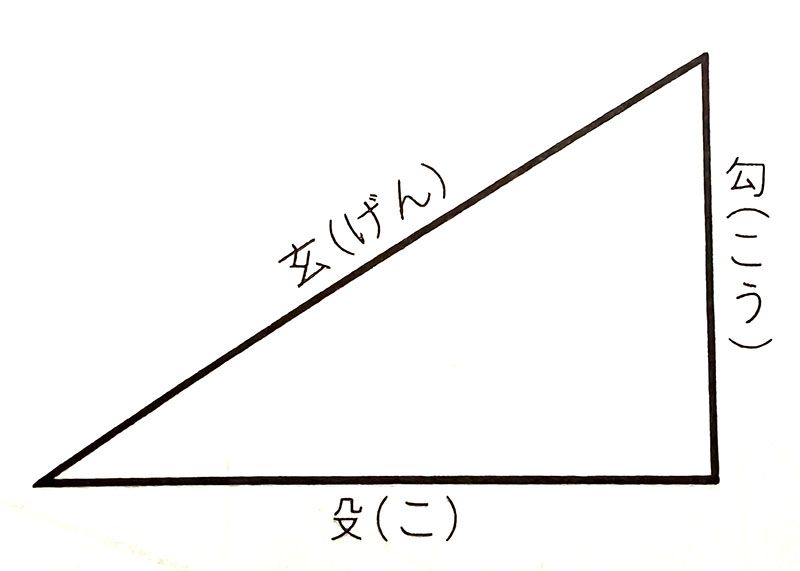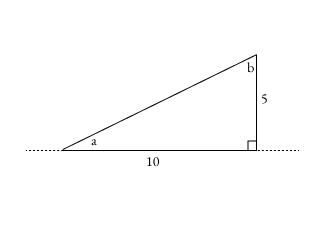Kou, ko, gen
Slopes, and the mysteries of the right triangle. Part 5 in a series.
This is part five in a series of posts:
- Sashigane 1: Introduction
- Sashigane 2: Traditional Units
- Sashigane 3: Physical design
- Sashigane 4: Hyoume and Urame
- Sashigane 5: Kou, ko, gen (this post)
- Sashigane 6: Simple usage
- Sashigane 7: Right triangle magic
Slopes, not angles
It turns out that Japanese carpenters almost never use angles or talk about “degrees”. All angles are considered as slopes (a rise over a run) called koubai (勾配) .

A run is called ko (殳 ).
A rise is called kou (勾 ).
It’s unfortunate that these two words sound so similar to western ears, but to Japanese natives, kou sounds completely different.
Enunciating slowly and distinctly, kou sounds like “ko ooh,” with two distinct beats, but run together (like a half-note instead of two quarter notes in music!). Kou when spoken makes a long “o” sound (kind of like the word “boat” but expressly drawn out for two beats: “bo-oat”) while ko sounds for just one beat (a quarter-note) and is clipped short.
A line connecting the start of the run to the top of the rise is called the gen (玄 ).
By convention, slopes are named assuming a fixed ko (run) of 10 sun. The kou (rise) is then used to express the slope. So a 4/10 slope would be referred to as 4 sun koubai.
Kanekoubai
A 45° slope is a special case: the rise is the same as the run. A 45° angle could be described as a slope of “10 koubai” or “10 sun koubai.” This special case is more commonly referred to as kanekoubai (矩勾配 ), however.
Hirakoubai and kaeshikoubai
By convention, slopes with a rise less than the run (angles less than 45°) are considered the common or ordinary case. This is called hirakoubai (平購買) .
Slopes with a greater rise than run (greater than 45° angles) are called kaeshikoubai (返し購買) or sometimes koubai no korobi (勾配の転び) , which means “upside down koubai.”
Note that hirakouba and kaeshikoubai slopes come in pairs.
For example, a slope of 5 sun koubai has a related kaeshikoubai slope of 10/5.
These are the two corners in a right triangle that aren’t 90°:

The slope labeled a is hirakoubai (a rise of 5 over a run of 10) and b is
the corresponding kaeshikoubai (with a “rise” of 10 over a “run” of 5).
Things get confusing soon, so it pays to ensure you fully understand the following five points:
The ko (run) is always the adjacent side, and the kou (rise) is always the opposite side.
By convention, slopes are normalized to a ko (run) of length 10. If you had a right triangle with sides that were, say, 3 sun and 6 sun long, you’d refer to the normal/conventional slope (or hirakoubai) as “5 sun koubai” (keeping the 3/6 ratio but scaling it to 5/10).
Further, the shallower slope (smaller angle) is the common or ordinary slope (hirakoubai) and is normally what gets called out.
A steeper slope (greater than 45° angle) is called kaeshikoubai and the kou now becomes a divisor rather than a dividend – you divide the ko (run) by the kou (rise) to get a kaeshikoubai slope (it’s the upside down slope).
Normally, one doesn’t refer to slopes (koubai) greater than 10.
If, for some reason, you wanted to work with a slope of, say, 25/10, you should instead think of it as the kaeshikoubai for a slope of 4 sun koubai.
That’s because the kaeshikoubai for a common slope (hirakoubai) of 10/25, which is equivalent to 40/100, which is the same as a slope of 4/10 or 4 sun koubai.)
Next, we’ll give all this theory and naming stuff a rest, and finally get to some practical applications for the sashigane.